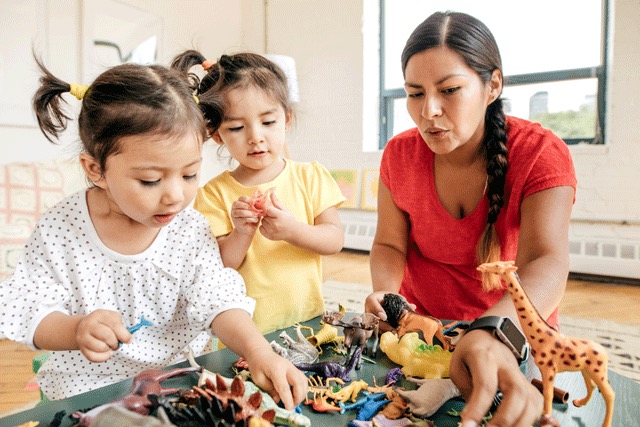As a new school year begins, teachers and caregivers of young children who are dual language learners (DLLs) have many opportunities to increase children’s vocabulary in both their heritage language and in English. Research has shown that when children have a rich vocabulary in both the heritage language and English, they are more likely to be successful when learning to read and other important literacy skills, such as writing. Teachers and caregivers of young DLLs can engage children in meaningful conversations that teach new words and explain their meaning.
There are many opportunities during the course of the day when teachers can engage children in conversations and introduce new words. Teachers and caregivers who are knowledgeable about the child’s cultural and family experiences can bring those experiences into conversations and use their knowledge of a word in their heritage language to teach the word in English. Teachers can learn about what children are involved in outside their preschool or child care program and bring those experiences into the classroom. Building on the child’s experiences and knowledge of vocabulary about those experiences in their heritage language creates a bridge for building vocabulary in English. Young children who are learning a second language will feel more confident having a conversation about something that they have directly experienced.
Project work is an excellent way to build upon children’s experiences and support vocabulary development in both languages. Teachers may be interested in reading about The Tamale Project as an example of how to connect young DLLs experiences to a classroom project. Ideally teacher-child conversations with young DLLs should include several “serve and receive” interactions. This means that the teacher and child keep their conversation going through several turns. Longer, sustained conversations provide young DLLs with opportunities to directly learn new vocabulary words, their meaning, and how to use them in conversations. During project work, teachers can also play the role of conversational mediator to assist DLLs during conversations with their peers as they collaborate on learning about a topic.
With preparation, sustained teacher-child conversations can take place throughout the daily routines (e.g., arrival, outdoor play, snack, etc.). Intentionally and directly teaching new vocabulary to DLLs through teacher-child conversations will have long lasting effects beyond the preschool years.

Bernie Laumann
Dr. Bernadette M. Laumann was the coordinator of the Illinois Early Learning Project from 2013 to 2019. She has been a child care teacher, an early childhood special education teacher, director of an inclusive early childhood program, researcher, and university teacher educator. Her research interests include mentoring and induction activities for beginning teachers and the use of technology in connecting evidence-based practice.
Biography current as of 2019
IEL Resources
- Project Example: The Tamale Project


